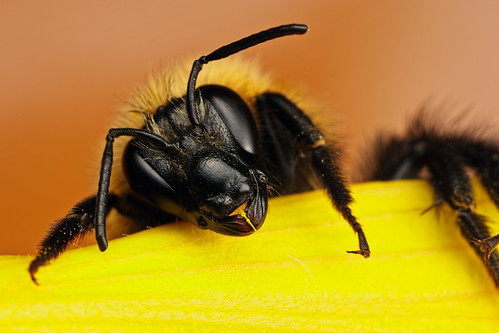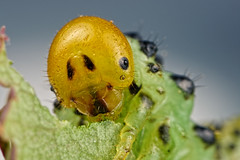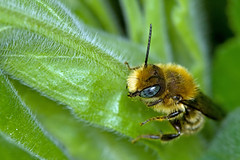A short video showing the "studio" that I set up for this shot, and the tools I carry in my camera bag.
Friday, August 30, 2013
Thursday, August 22, 2013
When to Focus Stack
The photo to the right is not mine, it belongs to a very talented macro photographer named Brian Valentine (LordV). Since I don't focus stack, and I wanted to show you an example of an image that really needs to be focus stacked, I asked Brian if I could use one of his images.
Take a close look at that water drop. The surface of the water has a texture to it and it's very fine grained. In order to make that water drop look round you have to record the texture detail on the surface, and that texture can be very easily erased by diffraction. So to get that texture you have to shoot with a small Fstop to avoid as much diffraction as possible. At the same time though you have to get enough depth to get the leading surface of the water drop, and the outside edge, in focus. So for an image like this dew drop refraction you really don't have any choice but to focus stack it
Edit: Brian reminded me that there's another reason to focus stack a dew drop refraction -the focus point of the flower is actually in front of the dew drop itself (the drop is acting as a lens).
There are a lot of really small subjects that, in my humble opinion, also need to be stacked to retain the texture detail in them. But is it really necessary to focus stack a large subject? For me the answer is no, I don't mind losing some extremely fine detail for more depth and it's one of the reasons why I don't focus stack. I'd rather spend my time getting the compositions and framing that I want, and since I shoot active subjects (or subjects that are going to get active soon) I don't have a lot of time.
Even though I shoot with a lens that's stopped down (usually F11 or higher) I still get a lot of detail in my images, and there are a couple of "tricks" to it: I look for ways to minimize movement, both mine and the subject's, because there are limits to how much motion the flash can freeze. Motion as little as the width of half a pixel while the flash is firing can amplify diffraction. It won't look like traditional motion blur, you'll just lose some fine detail. I'm convinced that macro is a form of flash based stop motion photography. Although it may not be as obvious as photographing a balloon in mid pop, or a bullet going through an apple, the principle is the same.
The other trick is to use a very well diffused light source. If the specular highlights in an image are strong (almost harsh) it can make an image look sharp, so you might think that using a light source that gives you those strong specular highlights is a good thing. But if the specular highlights are too strong the amount of sharpening that you can apply in post processing will be very limited, and it will be easy to over sharpen an image. Soft specular highlights that you can see texture, and even a little color, behind them are actually a lot better because you'll be able to apply a lot more sharpening in post.
Focus stacking a is a very useful tool, but it's not "the tool" for shooting macro. If you are just getting into macro then I'd encourage you not to focus stack. Get use to shooting single frames, and making the most out of what little depth you have by looking for angles that make the most of it (called "magic angles"). Once you have a grip on the mechanics (or muscle memory if you shoot hand held like Brian and I), and you're compositional skills are good, then take a look at focus stacking if you feel that you need it.
The last thing the macro discipline needs is one more photographer taking razor sharp poorly composed images. We're all practically drowning in them. Getting razor sharp images, at the expense of composition, is a prime example of not being able to see the forest because the trees are in the way...
Take a close look at that water drop. The surface of the water has a texture to it and it's very fine grained. In order to make that water drop look round you have to record the texture detail on the surface, and that texture can be very easily erased by diffraction. So to get that texture you have to shoot with a small Fstop to avoid as much diffraction as possible. At the same time though you have to get enough depth to get the leading surface of the water drop, and the outside edge, in focus. So for an image like this dew drop refraction you really don't have any choice but to focus stack it
Edit: Brian reminded me that there's another reason to focus stack a dew drop refraction -the focus point of the flower is actually in front of the dew drop itself (the drop is acting as a lens).
There are a lot of really small subjects that, in my humble opinion, also need to be stacked to retain the texture detail in them. But is it really necessary to focus stack a large subject? For me the answer is no, I don't mind losing some extremely fine detail for more depth and it's one of the reasons why I don't focus stack. I'd rather spend my time getting the compositions and framing that I want, and since I shoot active subjects (or subjects that are going to get active soon) I don't have a lot of time.
Even though I shoot with a lens that's stopped down (usually F11 or higher) I still get a lot of detail in my images, and there are a couple of "tricks" to it: I look for ways to minimize movement, both mine and the subject's, because there are limits to how much motion the flash can freeze. Motion as little as the width of half a pixel while the flash is firing can amplify diffraction. It won't look like traditional motion blur, you'll just lose some fine detail. I'm convinced that macro is a form of flash based stop motion photography. Although it may not be as obvious as photographing a balloon in mid pop, or a bullet going through an apple, the principle is the same.
The other trick is to use a very well diffused light source. If the specular highlights in an image are strong (almost harsh) it can make an image look sharp, so you might think that using a light source that gives you those strong specular highlights is a good thing. But if the specular highlights are too strong the amount of sharpening that you can apply in post processing will be very limited, and it will be easy to over sharpen an image. Soft specular highlights that you can see texture, and even a little color, behind them are actually a lot better because you'll be able to apply a lot more sharpening in post.
Focus stacking a is a very useful tool, but it's not "the tool" for shooting macro. If you are just getting into macro then I'd encourage you not to focus stack. Get use to shooting single frames, and making the most out of what little depth you have by looking for angles that make the most of it (called "magic angles"). Once you have a grip on the mechanics (or muscle memory if you shoot hand held like Brian and I), and you're compositional skills are good, then take a look at focus stacking if you feel that you need it.
The last thing the macro discipline needs is one more photographer taking razor sharp poorly composed images. We're all practically drowning in them. Getting razor sharp images, at the expense of composition, is a prime example of not being able to see the forest because the trees are in the way...
Friday, August 2, 2013
Impersonal Angles
I dialed up the way back machine to 2007 so I could show you an example, from my own gallery, of what you shouldn't do when composing your subjects. The image that I've included isn't necessarily bad -it has a lot going for it from a compositional perspective. But one thing that it's lacking is the connection between the subject and the viewer because you're forced to stare at the top of the critter's head, instead of seeing it at "eye level", and it's almost impossible to connect to it.
You wouldn't photograph the top of a persons head, so why shoot an insect from the top down?...
When composing your subjects try to do it from an angle that's at their level. It's much easier to convey a sense of personality when the viewer can make eye contact with the subject, like this shot:

I recently showed that image to one of my daughter's friends and she laughed because to her it looked like the bee was smiling. Changing people's perceptions of insects is one of the things that I'm trying to do with my photography, to get them to see the critters as more than just "bugs".
Truth be told I think that they do have distinct personalities, but their personality won't show in your work if you're shooting from impersonal angles...
You wouldn't photograph the top of a persons head, so why shoot an insect from the top down?...
When composing your subjects try to do it from an angle that's at their level. It's much easier to convey a sense of personality when the viewer can make eye contact with the subject, like this shot:

I recently showed that image to one of my daughter's friends and she laughed because to her it looked like the bee was smiling. Changing people's perceptions of insects is one of the things that I'm trying to do with my photography, to get them to see the critters as more than just "bugs".
Truth be told I think that they do have distinct personalities, but their personality won't show in your work if you're shooting from impersonal angles...
Subscribe to:
Posts (Atom)



